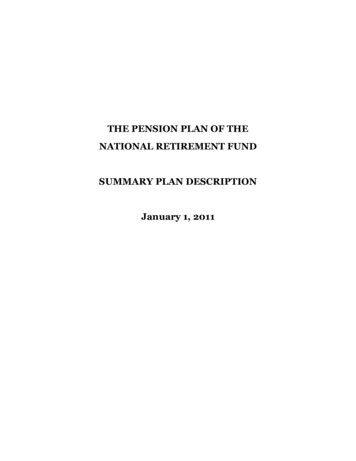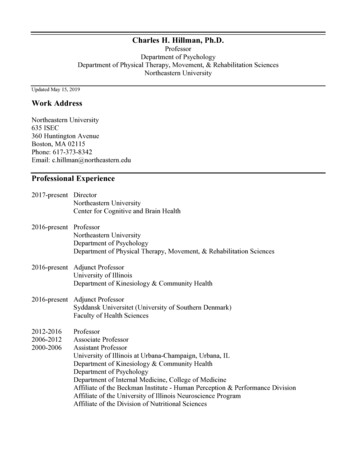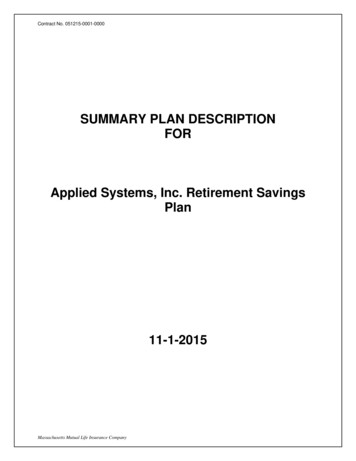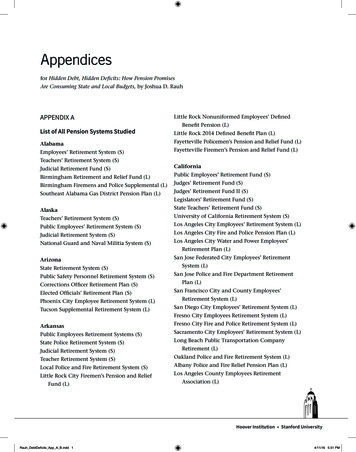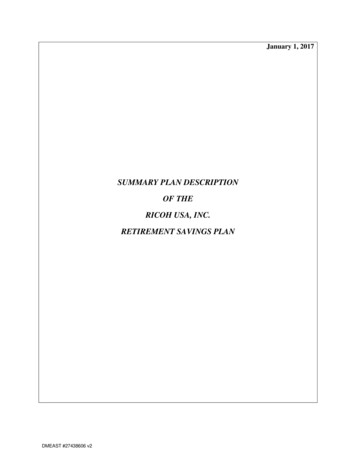
Transcription
NORTHEASTERN UNIVERSITY RETIREMENT PLANSUMMARY PLAN DESCRIPTION100225 100226
TABLE OF CONTENTSINTRODUCTION TO YOUR PLANARTICLE IPARTICIPATION IN THE PLANHow do I participate in the Plan? . 1How is my service determined for purposes of Plan eligibility? . 2What service is counted for purposes of Plan eligibility? . 2What happens if I'm a Participant, terminate employment and then I'm rehired? . 3ARTICLE IIEMPLOYEE CONTRIBUTIONSWhat are elective deferrals and how do I contribute them to the Plan? . 3What are rollover contributions? . 4ARTICLE IIIEMPLOYER CONTRIBUTIONSWhat is the Employer matching contribution and how is it allocated? . 4ARTICLE IVCOMPENSATION AND ACCOUNT BALANCEWhat compensation is used to determine my Plan benefits? . 4Is there a limit on the amount of compensation which can be considered? . 5Is there a limit on how much can be contributed to my account each year? . 5How is the money in the Plan invested? . 5Will Plan expenses be deducted from my account balance? . 6ARTICLE VVESTINGWhat is my vested interest in my account? . 6ARTICLE VIDISTRIBUTIONS PRIOR TO TERMINATION OF EMPLOYMENTCan I withdraw money from my account while working? . 6ARTICLE VIIDISTRIBUTIONS UPON TERMINATION OF EMPLOYMENTWhen can I get money out of the Plan? . 7What is Normal Retirement Age and what is the significance of reaching Normal Retirement Age? . 7What is Early Retirement Age? . 7When am I considered to be disabled under the Plan? . 7How will my benefits be paid to me? . 7May I elect another distribution method? . 8i
ARTICLE VIIIDISTRIBUTIONS UPON DEATHWhat happens if I die while working for the Employer? . 8Who is the beneficiary of my death benefit? . 8How will the death benefit be paid to my beneficiary? . 9When must payments be made to my beneficiary (required minimum distributions)? . 9What happens if I terminate employment, commence required minimum distribution payments and then die before receivingall of my benefits? . 9ARTICLE IXTAX TREATMENT OF DISTRIBUTIONSWhat are my tax consequences when I receive a distribution from the Plan? . 10Can I elect a rollover to reduce or defer tax on my distribution? . 10ARTICLE XLOANSIs it possible to borrow money from the Plan? . 10ARTICLE XIPROTECTED BENEFITS AND CLAIMS PROCEDURESAre my benefits protected? . 10Are there any exceptions to the general rule? . 10Can the Employer amend the Plan? . 11What happens if the Plan is discontinued or terminated? . 11How do I submit a claim for Plan benefits? . 11What if my benefits are denied? . 11What is the claims review procedure? . 12What are my rights as a Plan Participant?. 14What can I do if I have questions or my rights are violated? . 15ARTICLE XIIGENERAL INFORMATION ABOUT THE PLANPlan Name . 15Plan Number . 15Plan Effective Dates . 15Other Plan Information . 15Employer Information . 15Plan Administrator Information . 15ii
NORTHEASTERN UNIVERSITY RETIREMENT PLANSUMMARY PLAN DESCRIPTIONINTRODUCTION TO YOUR PLANNortheastern University Retirement Plan ("Plan") has been adopted to provide you with the opportunity to save for retirement on a taxadvantaged basis. This Plan is a type of retirement plan known as a 403(b) plan. This Summary Plan Description ("SPD") containsinformation regarding when you may become eligible to participate in the Plan, your Plan benefits, your distribution options, and manyother features of the Plan. You should take the time to read this SPD to understand the features of the Plan.This SPD addresses the most common questions you might have regarding the Plan. If this SPD does not answer all of your questions,please contact the Plan Administrator or other Plan representative. The Plan Administrator is generally responsible for responding toquestions and making determinations related to the administration, interpretation, and application of the Plan, unless those responsibilitieshave been delegated to other parties. The name of the Plan Administrator can be found at the end of this SPD in the Article entitled"General Information about the Plan."This SPD describes the Plan's benefits and obligations as contained in the legal Plan document, which governs the operation of the Plan.The Plan document is written in much more technical and precise language and is designed to comply with applicable legal requirements. Ifthe non-technical language in this SPD and the technical, legal language of the Plan document conflict, the Plan document always governs.If you wish to receive a copy of the legal Plan document, please contact the Plan Administrator.This SPD describes the current provisions of the Plan. The Plan is subject to federal laws, such as ERISA (the Employee RetirementIncome Security Act), the Internal Revenue Code and other federal and state laws which might affect your rights. The provisions of thePlan are subject to revision due to a change in laws or due to pronouncements by the Internal Revenue Service (IRS) or Department ofLabor. Your Employer may also amend or terminate this Plan. The Plan Administrator will notify you if the provisions of the Plan that aredescribed in this SPD change.Investment arrangement. The investment products you select (known as investment arrangements) may also affect the provisions of thePlan. In some cases the investment arrangements may limit your options under the Plan. This SPD does not address the provisions of thevarious investment arrangements. You should contact the Plan Administrator or the investment provider if you have questions about theprovisions of your specific investment arrangements.Types of contributions. The following types of contributions are allowed under this Plan: Employee elective deferrals Employer matching contributions Employee rollover contributionsARTICLE IPARTICIPATION IN THE PLANHow do I participate in the Plan?Provided you are not an Excluded Employee, you can begin participating under the Plan once you have satisfied the eligibilityrequirements and reached your Entry Date, except as indicated below for reclassified employees. The following describes ExcludedEmployees, the eligibility requirements and Entry Dates that apply. You should contact the Plan Administrator if you have questions aboutthe timing of your Plan participation.Elective DeferralsExcluded Employees. If you are a member of a class of employees identified below, you are an Excluded Employee and you are notentitled to participate in the Plan for purposes of elective deferrals. The employees who are excluded are: employees who are enrolled as students and regularly attending classes offered by the EmployerEligibility Conditions. You will be eligible to participate in elective deferrals on your date of hire. However, you will actuallyparticipate in elective deferrals once you reach the Entry Date as described below.Entry Date. For purposes of elective deferrals, your Entry Date will be your date of hire.1
Matching ContributionsExcluded Employees. If you are a member of a class of employees identified below, you are an Excluded Employee and you are notentitled to participate in the Plan for purposes of matching contributions. The employees who are excluded are: employees who are enrolled as students and regularly attending classes offered by the Employer temporary, non-student employees who work in a non-benefits eligible position for a specified limited period of time asdefined in the administrative manualEligibility Conditions. You will be eligible to participate in the Plan for purposes of matching contributions when you have satisfiedthe following eligibility condition(s). However, you will actually participate in matching contributions once you reach the Entry Dateas described below. attainment of age 21 completion of two (2) Years of ServiceSee "Additional Entry Date provisions" below for special provisions that might apply in determining Entry Dates.Additional Entry Date provisionsFor all applicable Contributions Participants will enter the plan, the first pay period after eligibility, and after the enrollment form iscompleted. See the Plan Administrator for additional information if you are not sure if this affects you.Reclassified EmployeeRegardless of the above, if it is determined that your Employer erroneously classified you as a non-Employee and you should have beentreated as an Employee, you are not entitled to participate in the Plan.How is my service determined for purposes of Plan eligibility?Year of Service. You will be credited with a Year of Service at the end of the twelve-month period beginning on your date of hire if youhave been credited with at least 1,000 Hours of Service for such period. If you have not been credited with 1,000 Hours of Service by theend of such period, you will have completed a Year of Service at the end of any following Plan Year during which you were credited with1,000 Hours of Service.Hour of Service. You will be credited with your actual Hours of Service for:(a) each hour for which you are directly or indirectly compensated by the Employer for the performance of duties during the PlanYear;(b) each hour for which you are directly or indirectly compensated by the Employer for reasons other than the performance of duties(such as vacation, holidays, sickness, disability, lay-off, military duty, jury duty or leave of absence during the Plan Year) but creditwill not exceed 501 hours of service for any single continuous period during which you perform no duties; and(c) each hour for back pay awarded or agreed to by the Employer.You will not be credited for the same Hours of Service both under (a) or (b), as the case may be, and under (c).What service is counted for purposes of Plan eligibility?Service with the Employer. In determining whether you satisfy the minimum service requirements to participate under the Plan, allservice you perform for the Employer will generally be counted. However, there are some exceptions to this general rule.Break in Service rules. If you terminate employment and are rehired, you may lose credit for prior service under the Plan's Break inService rules.For eligibility purposes, you will have a Break in Service if you complete less than 501 Hours of Service during the computationperiod used to determine whether you have a Year of Service. However, if you are absent from work for certain leaves of absencesuch as a maternity or paternity leave, you may be credited with enough Hours of Service to prevent a Break in Service.Two-year eligibility Break in Service rule. To be eligible to receive certain contributions under the Plan, you must complete at leasttwo (2) Years of Service. This requirement is only satisfied if you complete two (2) Years of Service without an intervening Break inService (as defined above).2
Service with Predecessor Employer. For eligibility purposes, your Years of Service with the following Employers will be counted. Seethe Plan Administrator for details if you think you may be affected by this provision. any Predecessor which is: Service with an Educational Organization providing post-secondary education will be recognized only if the prior serviceended no more than four months before service with the Employer beganMilitary Service. If you are a veteran and are reemployed under the Uniformed Services Employment and Reemployment Rights Act of1994, your qualified military service might be considered service with the Employer. If you might be affected by this law, ask the PlanAdministrator for further details.What happens if I'm a Participant, terminate employment and then I'm rehired?If you are no longer a Participant because of a termination of employment, and you are rehired, then you will be able to participate in thePlan on the date on which you are rehired if you are otherwise eligible to participate in the Plan provided your prior service had not beendisregarded under the Break in Service rules.ARTICLE IIEMPLOYEE CONTRIBUTIONSWhat are elective deferrals and how do I contribute them to the Plan?Elective Deferrals. As a Participant under the Plan, you may elect to reduce your compensation by a specific percentage and have thatamount contributed to the Plan on a pre-tax basis as an elective deferral. Your taxable income is reduced by the elective deferralcontribution so you pay less in federal income taxes (however, the amount you defer is still counted as compensation for purposes of SocialSecurity taxes). Later, when the Plan distributes the elective deferrals and earnings, you will pay the taxes on those elective deferrals andthe earnings. Therefore, federal income taxes on the elective deferral contributions and on the earnings are only postponed. Eventually, youwill have to pay taxes on these amounts.You will always be 100% vested in your elective deferrals (see the Article in this SPD entitled "Vesting").Elective Deferral procedure. The amount you elect to defer will be deducted from your pay in accordance with a procedure established bythe Plan Administrator. If you wish to defer, the procedure will require that you enter into a Salary Reduction Agreement. You may elect todefer a portion of your compensation payable on or after your Entry Date. Such election will become effective as soon as administrativelyfeasible after it is received by the Plan Administrator. Your election will generally remain in effect until you modify or terminate it.Elective Deferral modifications. You may revoke or make modifications to your salary deferral election in accordance with proceduresthat the Employer provides. See the Plan Administrator for further information.Elective Deferral Limit. As a Participant, you may elect to defer a percentage of your compensation each year instead of receiving thatamount in cash. Your total elective deferrals in any taxable year cannot exceed a dollar limit which is set by law. The limit for 2020 is 19,500. After 2020, the dollar limit may increase for cost-of-living adjustments. See the paragraph below on Annual dollar limit.Age 50 Catch-Up Deferrals. If you are at least age 50 or will attain age 50 before the end of a calendar year, then you may elect to deferadditional amounts (called Age 50 Catch-Up Deferrals) to the Plan as of the January 1st of that year. You can defer the additional amountsregardless of any other limitations on the amount you can defer to the Plan. The maximum Age 50 Catch-Up Deferrals that you can makein 2020 is 6,500. After 2020, the maximum might increase for cost-of-living adjustments. Any Age 50 Catch-Up Deferrals that you makewill be taken into account in determining any Employer matching contribution made to the Plan.Annual dollar limit. You should also be aware that each separately stated annual dollar limit on the amount you may defer (the annualdeferral limit and the "catch-up contribution" limit) is a separate aggregate limit that applies to all such similar salary deferral amounts and"catch-up contributions" you may make under this Plan and any other cash or deferred arrangements (including other tax-sheltered 403(b)annuity contracts, simplified employee pensions or 401(k) plans) in which you may be participating. Generally, if an annual dollar limit isexceeded, then the excess must be returned to you in order to avoid adverse tax consequences. For this reason, it is desirable to request inwriting that any such excess salary deferral amounts and "catch-up contributions" be returned to you.If you are in more than one plan, you must decide which plan or arrangement you would like to return the excess. If you decide that theexcess should be distributed from this Plan, you must communicate this in writing to the Plan Administrator no later than the March 1stfollowing the close of the calendar year in which such excess deferrals were made. However, if the entire dollar limit is exceeded in thisPlan or any other plan the Employer maintains, then you will be deemed to have notified the Plan Administrator of the excess. The PlanAdministrator will then return the excess deferral and any earnings to you by April 15th.3
What are rollover contributions?Rollover contributions. Subject to the provisions of your investment arrangements and at the discretion of the Plan Administrator, if youare a Participant in the Plan, you might be permitted to deposit into the Plan distributions you have received from other plans and certainIRAs. Such a deposit is called a "rollover" contribution and might result in tax savings to you. You may ask the Plan Administrator of theother plan or the trustee or custodian of the IRA to directly transfer (a "direct rollover") to this Plan all or a portion of any amount that youare entitled to receive as a distribution from such plan. Alternatively, you may elect to deposit any amount eligible to be rolled over within60 days of your receipt of the distribution. You should consult qualified counsel to determine if a rollover is in your best interest.Rollover account. Your rollover contribution will be accounted for in a "rollover account." You will always be 100% vested in your"rollover account" (see the Article in this SPD entitled "Vesting"). Rollover contributions will be affected by any investment gains orlosses.Withdrawal of rollover contributions. You may withdraw the amounts in your "rollover account" at any time.ARTICLE IIIEMPLOYER CONTRIBUTIONSThis Article describes Employer contributions that will be made to the Plan and how your share of the contributions is determined.What is the Employer matching contribution and how is it allocated?Amounts taken into account. Matching contributions are only based on your elective deferrals made into the basic retirement portion(TIAA plan number 100225 and Fidelity account 89948, sources 01 and 02).Matching Contribution. Your Employer will make a matching contribution equal to 10% of your compensation provided your electivedeferrals equal or exceed 5% of your compensation.Matching catch-up deferrals. If you make Age 50 Catch-Up Deferrals then The Employer will match the age 50 catch-ups made to thebasic retirement portion (TIAA plan number 100225 and Fidelity account 89948, sources 01 and 02).Allocation conditions. You will always share in the matching contribution regardless of the amount of service you complete during thePlan Year.ARTICLE IVCOMPENSATION AND ACCOUNT BALANCEWhat compensation is used to determine my Plan benefits?All ContributionsDefinition of compensation. Compensation is defined as your total compensation that is subject to income tax and paid to you by yourEmployer for the Plan Year.Adjustments to compensation. Regardless of the definition of compensation, the following adjustments will be made: elective deferrals to this Plan and to any other plan or arrangement (such as a cafeteria plan) will be included. compensation paid while not a Participant in the component of the Plan for which compensation is being used will be excluded. overtime will be excluded. extra compensation as defined as a one-time payment for a specific event or contribution or for performing short term additionalwork.Elective DeferralsAdjustments to compensation. In addition to adjustments to compensation under "All Contributions" above, the following adjustments tocompensation will be made for purposes of elective deferrals: compensation paid after you terminate is generally excluded for Plan purposes. However, the following amounts will be includedin compensation even though they are paid after you terminate employment, provided these amounts would otherwise have beenconsidered compensation as described above and provided they are paid within 2 1/2 months after you terminate employment, or iflater, the last day of the Plan Year in which you terminate employment:4
compensation paid for services performed during your regular working hours, or for services outside your regular workinghours (such as overtime or shift differential), or other similar payments that would have been made to you had you continuedemployment.Matching ContributionsAdjustments to compensation. In addition to adjustments to compensation under "All Contributions" above, the following adjustments tocompensation will be made for purposes of matching contributions: compensation paid after you terminate is generally excluded for Plan purposes. However, the following amounts will be includedin compensation even though they are paid after you terminate employment, provided these amounts would otherwise have beenconsidered compensation as described above and provided they are paid within 2 1/2 months after you terminate employment, or iflater, the last day of the Plan Year in which you terminate employment: compensation paid for services performed during your regular working hours, or for services outside your regular workinghours (such as overtime or shift differential), or other similar payments that would have been made to you had you continuedemployment.Is there a limit on the amount of compensation which can be considered?The Plan, by law, cannot recognize annual compensation in excess of a certain dollar limit. The limit for the Plan Year beginning in 2020 is 285,000. After 2020, the dollar limit might increase for cost-of-living adjustments.Is there a limit on how much can be contributed to my account each year?The law imposes a limit on the amount of contributions (both Employer contributions and elective deferrals, but excluding Age 50 CatchUp Deferrals) that may be made to your accounts during a year. For 2020, this total cannot exceed the lesser of 57,000 or 100% of yourincludible compensation (generally your compensation for the prior 12-month period, as limited under the previous question). After 2020,the dollar limit might increase for cost-of-living adjustments.The above limit may also need to be applied by taking into account contributions made to other retirement plans in which you area participant. If you have more than 50% control of a corporation, partnership, and/or sole proprietorship, then the above limit is based oncontributions made in this Plan as well as contributions made to any 403(b) or qualified plans maintained by the businesses you control. Ifyou control another business that maintains a plan in which you participate, then you are responsible for providing the Plan Administratorwith information necessary to apply the annual contribution limits. If you fail to provide necessary and correct information to the PlanAdministrator, it could result in adverse tax consequences to you, including the inability to exclude contributions to the Plan from yourgross income for tax purposes.How is the money in the Plan invested?The Plan assets may be invested in mutual funds and Annuity Contracts. See the Plan Administrator for further details regardingpermissible investments.You will be able to direct the investment of your Plan account, including your elective deferrals. The Plan Administrator will provide youwith information on the investment choices available to you, the frequency with which you can change your investment choices and otherinformation. If you do not direct the investment of your Plan account, then your account will be invested in accordance with the defaultinvestment alternatives your Employer establishes under the Plan. These default investments will be made in accordance with specific rulesunder which the fiduciaries of the Plan, including your Employer and the Plan Administrator, will be relieved of any legal liability for anylosses resulting from the default investments. The Plan Administrator has or will provide you with a separate notice which details thesedefault investments and your right to switch out of the default investment if you so desire.The Plan is intended to comply with Section 404(c) of ERISA (the Employee Retirement Income Security Act). If the Plan complies withthis Section, then the fiduciaries of the Plan, including your Employer and the Plan Administrator, will be relieved of any legal liability forany losses which are the direct and necessary re
Northeastern University Retirement Plan ("Plan") has been adopted to provide you with the opportunity to save for retirement on a tax advantaged basis. This Plan is a type of retirement plan known as a 403(b) plan. This Summary Plan Description ("SPD") contains
